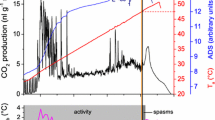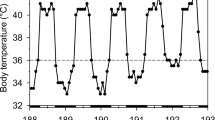Abstract
In spite of the abundance and broad distribution of social wasps, little information exists concerning thermoregulation by individuals. We measured body temperatures of the yellowjackets Vespula germanica and V. maculifrons and examined their thermoregulatory mechanisms. V. germanica demonstrated thermoregulation via a decreasing gradient between thorax temperature and ambient temperature as ambient temperature increased. V. maculifrons exhibited a constant gradient at lower ambient temperatures but thorax temperature was constant at high ambient temperatures. Head temperature exhibited similar patterns in both species. In spite of low thermal conductances, a simple heat budget model predicts substantial heat loads in warm conditions in the absence of thermoregulation. Both species regurgitated when heated on the head. A smaller volume of regurgitant was produced at lower head temperatures and a larger volume at higher head temperatures. Small regurgitations resulted in stabilization of head temperature, while large ones resulted in 4°C decreases in head temperature. Regurgitation was rare when wasps were heated upon the thorax. Abdomen temperature was 3–4°C above ambient temperature, and approached ambient temperature under the hottest conditions. No evidence was found for shunting of hot hemolymph from thorax to abdomen as a cooling mechanism. The frequency of regurgitation in workers returning to the nest increased with ambient temperature. Regurgitation may be an important thermoregulatory strategy during heat stress, but is probably not the only mechanism used in yellowjackets.
Similar content being viewed by others

Abbreviations
- M b :
-
body mass
- M th :
-
thorax mass
- T a :
-
ambient temperature
- T ab :
-
abdomen temperature
- T b :
-
body temperature
- T h :
-
head temperature
- T th :
-
thorax temperature
- C t :
-
thermal conductance
References
Akre RD, Greene A, MacDonald JF, Landolt PJ, Davis HG (1981) The yellowjackets of America north of Mexico. United States Department of Agriculture, Agriculture Handbook no. 552
Archer ME (1977) The weights of forager loads of Paravespula vulgaris (Linn.) (Hymenoptera: Vespidae) and the relationship of load weight to forager size. Ins Soc 24: 95–102
Coelho JR (1991a) The effect of thorax temperature on force production during tethered flight in honeybee (Apis mellifera) drones, workers, and queens. Physiol Zool 64: 823–835
Coelho JR (1991b) Heat transfer and body temperature in honey bee (Hymenoptera: Apidae) drones and workers. Environ Entomol 20: 1627–1635
Coelho JR, Hoagland J (1995) Load-lifting capacities of three species of yellowjackets (Vespula) foraging on honey-bee corpses. Funct Ecol 9: 171–174
Church NS (1960) Heat loss and the body temperature of flying insects. II. Heat conduction within the body and its loss by radiation and convection. J Exp Biol 37: 186–213
Cooper PD, Schaffer WM, Buchmann SL (1985) Temperature regulation of honey bees (Apis mellifera) foraging in the Sonoran desert. J Exp Biol 114: 1–15
Dyer FC, Seeley TD (1987) Interspecific comparisons of endothermy in honey-bees (Apis): deviations from the expected size-related patterns. J Exp Biol 127: 1–26
Free JB (1970) The behavior of wasps (Vespula germanica L. and V. vulgaris L.) when foraging. Ins Soc 17: 11–20
Green A (1991) Dolichovespula and Vespula. In: Ross KG, Matthews RW (eds) The social biology of wasps. Cornell University Press, Ithaca, pp 263–305
Harris RJ, Moller H, Winterbourn MJ (1994) Competition for honeydew between two social wasps in South Island beech forests, New Zealand. Ins Soc 41: 379–394
Harrison JF, Nielsen DI, Page RE (1994) Thermal and MDH phenotype effects on flight metabolism in honey bees. Am Zool 34: 85A
Heinrich B (1979) Thermoregulation of African and European honeybees during foraging, attack, and hive exits and returns. J Exp Biol 80: 217–229
Heinrich B (1980a) Mechanisms of body-temperature regulation in honeybees, Apis mellifera. I. Regulation of head temperature. J Exp Biol 85: 61–72
Heinrich B (1980b) Mechanisms of body-temperature regulation in honeybees, Apis mellifera. II. Regulation of thorax temperature at high ambient temperatures. J Exp Biol 85: 73–87
Heinrich B (1984) Strategies of thermoregulation and foraging in two vespid wasps, Dolichovespula maculata and Vespula vulgaris. J Comp Physiol B 154: 175–179
Heinrich B (1993) The hot-blooded insects. Strategies and mechanisms of thermoregulation. Harvard University Press, Cambridge, Mass., USA
Kammer AE (1981) Physiological mechanisms of thermoregulation. In: Heinrich B (ed) Insect thermoregulation. Wiley, New York, pp 80–115
Kurczewski FE (1968) Vespula maculifrons (Hymenoptera: Vespidae) preying on the European earwig (Forficula auricularia). J N Y Entomol Soc 76: 84–86
May ML, Casey TM (1983) Thermoregulation and heat exchange in euglossine bees. Physiol Zool 56: 541–551
Roberts SP, Hadley NF, Harrison JF (1994) Water loss and metabolic rate during flight in the bees Centris pallida and Apis mellifera. Am Zool 34: 30A
Seber GAF (1977) Linear regression analysis. Wiley, New York
Seeley T, Heinrich B (1981) Regulation of temperature in the nests of social insects. In: Heinrich B (ed) Insect thermoregulation. Wiley, New York, pp 159–234
Stein KJ, Fell RD (1994) Correlation of queen sperm content with colony size in yellowjackets (Hymenoptera: Vespidae). Envir Entomol 23: 1497–1500
Stone GN, Willmer PG (1989) Endothermy and temperature regulation in bees: a critique of the ‘grab and stab’ measurement of body temperature. J Exp Biol 143: 211–233
Author information
Authors and Affiliations
Additional information
Communicated by L.C.-H. Wang
Rights and permissions
About this article
Cite this article
Coelho, J.R., Ross, A.J. Body temperature and thermoregulation in two species of yellowjackets, Vespula germanica and V. maculifrons . J Comp Physiol B 166, 68–76 (1996). https://doi.org/10.1007/BF00264641
Accepted:
Issue Date:
DOI: https://doi.org/10.1007/BF00264641



